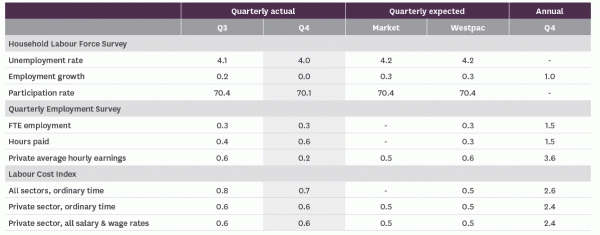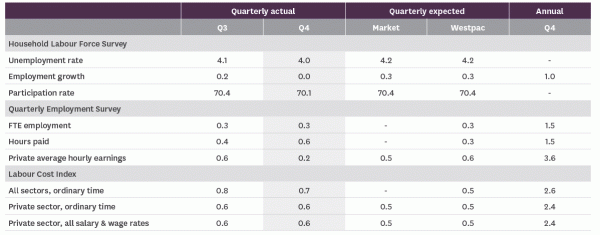- The unemployment rate fell to 4.0% in the December quarterly, equalling its lowest level since 2008.
- The details of the survey weren’t entirely positive, with weak employment growth and falling labour force participation.
- Nevertheless, there was a clear message that the labour market has tightened.
- Wage growth is picking up, even outside of the influence of public sector pay agreements.
- Today’s results reinforce our view that the Reserve Bank will leave the OCR on hold at next week’s review
The labour market surveys for the December quarter saw a dip in unemployment and a further pickup in wage inflation. The results were stronger than we, the market or the Reserve Bank expected. And while the details of the surveys weren’t entirely complementary about the strength of the economy itself, they clearly point to a labour market that is tight, suggesting further upward pressure on wages and prices.
The unemployment rate fell to 4.0% in December, from a downwardly revised 4.1% in September. That equalled its lowest level since the Global Financial Crisis – though it first reached this mark back in September 2018, and has bobbled around these levels since then rather than improving further.
Looking at a broader range of measures, as the Reserve Bank does, reinforces the message that the labour market has tightened. The underutilisation rate – which also includes part-time workers who are seeking more work, and people who could potentially be brought into the labour force – has continued to fall, reaching an 11-year low of 10.0%.
The low rate of unemployment doesn’t denote a strong economy, though. GDP growth has clearly slowed in the last year, and employment growth has softened along with it. Employment was actually flat for the quarter in the Household Labour Force Survey (HLFS), even weaker than expected. The Quarterly Employment Survey (QES) measures fared a little better, particularly the 0.6% rise in hours worked for the quarter. But even on this measure the annual rate of growth has slowed markedly in the last year.
At the same time, we’ve seen a marked rise in the number of people leaving the workforce altogether. The participation rate fell to 70.1% in December, compared to 70.4% in September and a record high of 70.9% in 2018.
The fall in participation in the last year or so is especially notable because, up until then, New Zealand had been a star performer on this measure. Participation had risen to an all-time high by 2018, and projections suggested that it could remain at these levels for several more years, even with a growing share of the workforce reaching retirement age.
The recent pullback in participation is difficult to explain, as there doesn’t seem to be one single factor at play. Initially it appeared to be driven by men between 55 and 65, suggesting a wave of early retirement – but that has reversed somewhat in the last two quarters. And for the December quarter itself the fall was concentrated among women under 25. Both of these developments could just amount to noise in the survey, but we’ll continue to keep an eye out for broader trends.
One factor that we can more confidently rule out is the slowdown in net migration from its highs. Neither of the previously mentioned groups match the profile of the migrant flows seen in recent years, which have largely been in the 25- 40 age group.
Whatever the causes, it’s clear that the supply of labour remains tight relative to demand. We estimate a ‘neutral’ unemployment rate to be around 4.5%, which implies that the labour market has been on the ‘tight’ side for more than a year. By now we’d expect to see an acceleration in wage growth, and that has indeed been the case.
The Labour Cost Index (LCI) rose by 0.7% for the quarter, lifting the annual growth rate to a fresh ten-year high of 2.6%. Public sector wage growth was particularly strong, even though to our knowledge there were no collective agreements that would have affected this quarter. But private sector wage growth also rose by 0.6% for the quarter, a larger increase than we expected.
The QES measure of average hourly earnings was more subdued, with a rise of 0.3% (and just 0.1% for the private sector) in the December quarter. However, this measure tends to be more volatile than the LCI, and has seen a more marked acceleration in the last couple of years.
Overall, today’s results will be a positive surprise for the Reserve Bank. The labour market appears to be, if anything, running on the hotter side of maximum sustainable employment. And with wage inflation stirring again after a long dormant period, that should give the RBNZ more comfort about getting inflation up to the 2% midpoint of its target range on a sustained basis. Next Wednesday’s Monetary Policy Statement will need to strike a balance between a stronger picture of domestic inflation pressures, and the rapidly developing risks in the global environment.



 Signal2forex.com - Best Forex robots and signals
Signal2forex.com - Best Forex robots and signals




